The AMD Llano Notebook Review: Competing in the Mobile Market
by Jarred Walton & Anand Lal Shimpi on June 14, 2011 12:01 AM EST
High Detail Gaming and Asymmetrical CrossFire Misfire
Update, 8/10/2011: Just to let you know, AMD managed to get me a new BIOS to address some of the rendering issues I experienced with CrossFire. As you'll read below, I had problems in several titles, and I still take exception with the "DX10/11 only" approach. I can name dozens of good games out there that are DX9-only that released in the past year. Anyway, the updated BIOS has at least addressed the rendering errors I noticed, so retail Asymmetrical CrossFire laptops should do better. With that disclaimer out of the way, here's my initial experience from two months back.
So far, the story for Llano and gaming has been quite good. The notebook we received comes with the 6620G fGPU along with a 6630M dGPU, though, and AMD has enabled Asymmetrical CrossFire...sort of. The results for ACF in 3DMarks were interesting if only academic, so now we're going to look at how Llano performs with ACF enabled and running at our High detail settings (using an external LCD).
Just a warning before we get to the charts: this is preproduction hardware, and AMD informed us (post-review) that they stopped worrying about fixing BIOS issues on this particular laptop because it isn't going to see production. AMD sent us an updated driver late last week that was supposed to address some of the CrossFire issues, but in our experience it didn’t help and actually hurt in a few titles. Given that the heart of the problem is in the current BIOS, that might also explain why Turbo Core doesn't seem to be working as well as we would expect.
AMD also notes that the current ACF implementation only works on DX10/11 games, and at present that's their plan going forwards as the majority of software vendors state they will be moving to DX10/11. While the future might be a DX10/11 world, the fact is that many recent titles are still DX9 only. Even at our "High" settings, five of our ten titles are tested in DX9 mode (DiRT 2, L4D2, Mafia II, Mass Effect 2, and StarCraft II—lots of twos in there, I know!), so they shouldn't show any improvement...and they don't. Of those five titles, four don't have any support for DX10/11 (DiRT 2 being the exception), and even very recent, high-profile games are still shipping in DX9 form (e.g. Crysis 2, though a DX11 patch is still in the works). Not showing an improvement is one thing, but as we'll see in a moment, enabling CrossFire mode actually reduces performance by 10-15% relative to the dGPU. That's the bad news. The good news is that the other half of the games show moderate performance increases over the dGPU.
If that doesn't make the situation patently clear, CrossFire on our test unit is largely not in what we consider a working state. With that out of the way, here are the results we did managed to cobble together:
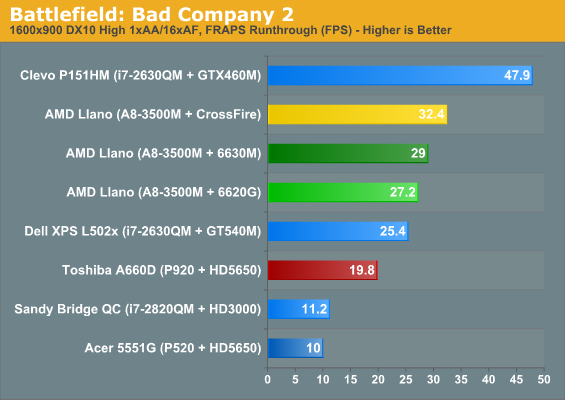
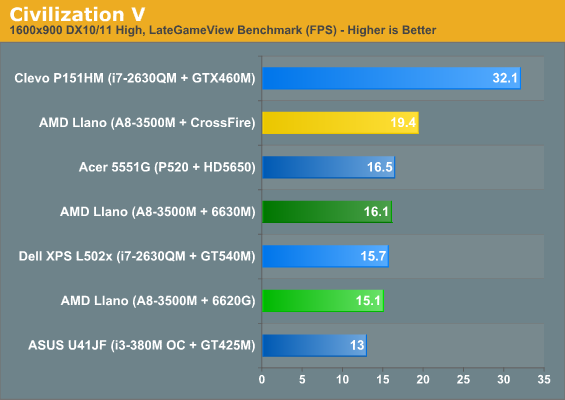
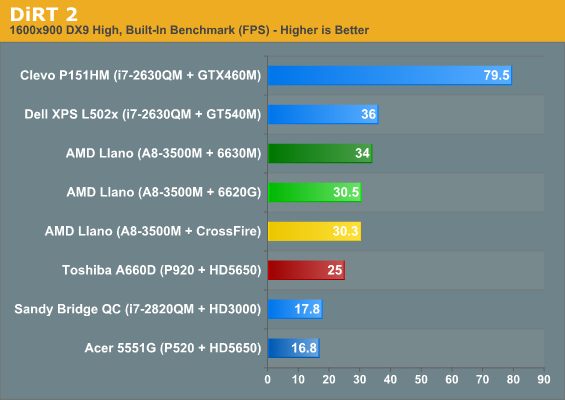
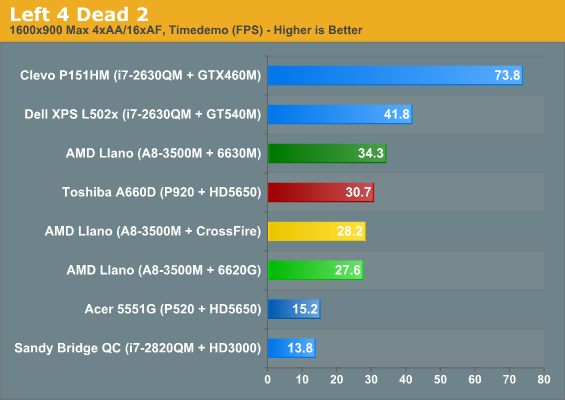
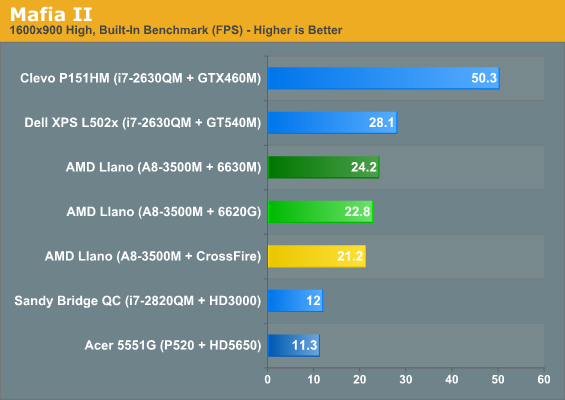

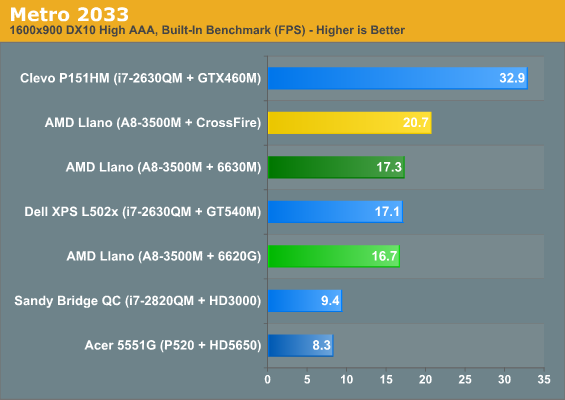
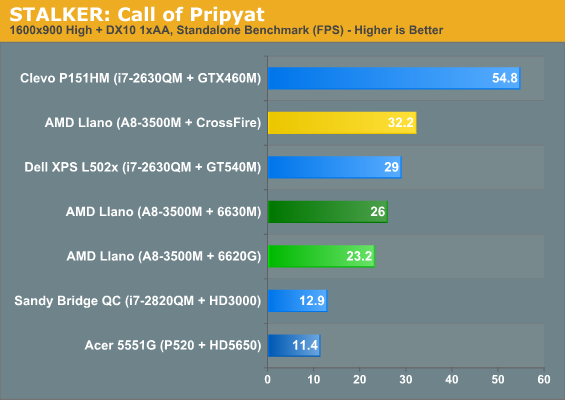
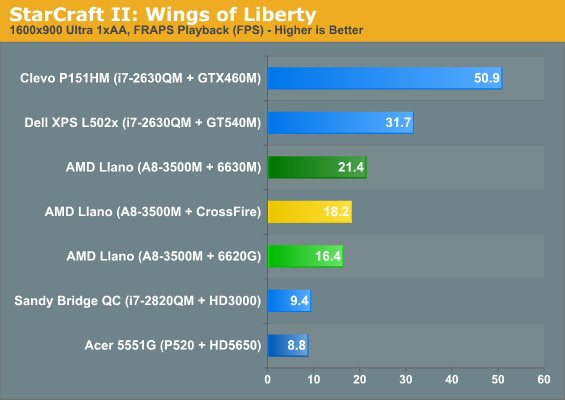
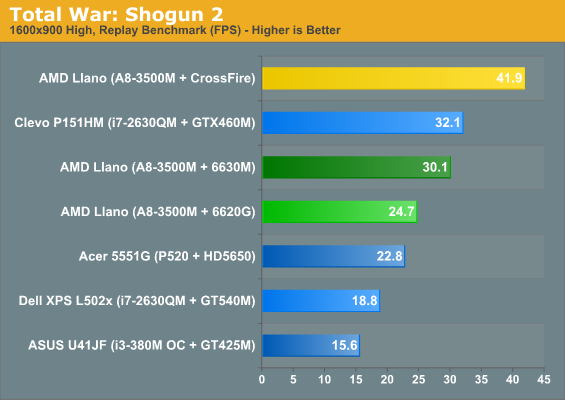
Given this is preproduction hardware that won't see a store shelf, the above results are almost meaningless. If ACF can provide at least a 30% increase on average, like what we see in TWS2, it could be useful. If it can't do at least 30%, it seems like switchable graphics with an HD 6730M would be less problematic and provide better performance. The only takeaway we have right now is that ACF is largely not working on this particular unit. Shipping hardware and drivers should be better (they could hardly be worse), but let's just do a quick discussion of the results.
If we just look at games with DX10/11 enabled, the story isn't too bad. Not accounting for the rendering issues noted below, ACF is able to boost performance by an average of 24% over the dGPU at our High settings. We didn’t include the Low and Medium results for ACF on the previous page for what should be obvious reasons, but if the results at our High settings are less than stellar, Low and Medium settings are even less impressive. Trimming our list of titles to three games (we tested TWS2 and STALKER in DX9 mode at our Low and Medium settings), ACF manages to average a 1% performance increase over the dGPU at Low and a 14% increase at Medium, but Civ5 still had to contend with rendering errors and Metro 2033 showed reduced performance.
In terms of rendering quality, ACF is very buggy on the test system; the default BIOS settings initially resulted in corrupted output for most games and 3D apps, but even with the correct settings we still encountered plenty of rendering errors. Civilization V only had one GPU rendering everything properly while units were missing on the other GPU, so you’d get a flicker every other frame with units appearing/disappearing. At higher detail settings, the corruption was even more severe. STALKER: Call of Pripyat and Total War: Shogun 2 also had rendering errors/flickering at higher quality settings. Since we didn't enable DX10/11 until our High defaults, right when ACF is supposed to start helping is where we encountered rendering issues.
Just to be clear: none of this means that Asymmetrical CrossFire is a bad idea; it just needs a lot more work on the drivers and BIOS. If/when we get a retail notebook that includes Asymmetrical CrossFire support, we’ll be sure to revisit the topic. Why ACF isn’t supported in DX9 is still a looming question, and AMD’s drivers need a much better interface for managing switchable graphics profiles. A list of all supported games with a central location to change all the settings would be a huge step up from the current UI, and users need the ability to enable/disable CrossFire support on a per-game basis if AMD wants anyone to actually use ACF. We also hope AMD rethinks their “only for DX10/DX11 modes” stance; CrossFire has worked with numerous DX9 games in the past, and what we’d like to see is ACF with the same list of supported games as regular CrossFire. If nothing else, having ACF enabled shouldn't reduce performance in DX9 titles.
In summary: we don't know if ACF will really help that much. We tested Asymmetrical CrossFire on what is, at best, beta hardware and drivers, and it didn't work very well. We want it to work, and the potential is certainly there, but we'll need to wait for a better test platform. To be continued....










177 Comments
View All Comments
ET - Wednesday, June 15, 2011 - link
It may be impossible to know the exact speed the cores run, but it would be interesting to run a test to get some relative numbers.You can run a single threaded CPU bound program such as SuperPI, then run it again with the other three cores at 100% (for example by having another three instances of SuperPI running). Do this on AC and battery, and it might generate some interesting numbers. At the very least we'll be able to tell whether the 1.5GHz -> 2.4GHz ratio looks right.
ET - Wednesday, June 15, 2011 - link
By the way, I just read Tom's Hardware review, which was unique in that it compared to a Phenom II X4 running at 1.5GHz and 2.4GHz. It looked from these benchmarks like the A8-3500M is always performing around the 1.5GHz level of the Phenom II X4 (sometimes it's a little faster, sometimes a little slower), which suggests that Turbo Core doesn't really kick in.i_am_the_avenger - Wednesday, June 15, 2011 - link
Maybe this will cheer the AMD Fans a bitThis article did not mention some nifty features the APUs have (or maybe it did I did not read it line by line)...................................
Watch the video below from engadget:
http://www.engadget.com/2011/06/13/amds-fusion-a-s...
It shows how these APUs can smooth out shaking videos real time, even while streaming from Youtube! and it does a very good job.
Another feature is how it en-chances videos (colour etc.)
This improves general user PC experience.......... something very desirable
The video also shows how AMD wants to target general users and not work enthusiasts
Another video shows comparison between the i7-2630QM and A8-3500M while multitasking video related applications.
http://www.engadget.com/2011/03/01/amd-compares-up...
---Interesting to note that the APU Gradually increased its power consumption while i7 was like bursting to and fro, something the way turbo core acts maybe-----
I think it is work vs general performance,
Intel's great for work, when you need to finish tasks and it needs to be done quickly,
while AMD APUs give you a good over all pc and multimedia performance - you watch videos, play games, so what if the zip file extracts a minute late and the fGPU performance is great....
You may buy a i7 SNB with discreate GPU but that has a battery life hit (for same battery capacity) and also extra heat generation which requires more fans, also the extra weight..
Please don't start judging me or something....
I am getting confused myself, while intel looks great in every way except stock gaming and battery life(not that bad)... I think I don't need that much power, even if I work - my work isn't so CPU oriented that an i7 would matter, a 30 second task finishes in 20 ok but it does not matter to me..... but improved video and battery seems more useful to me
I don't think that all of us have to tax our CPUs to full potential -- a few have to, not considering them -- so even if Intel have faster processors for many it does not affect them as much.
psychobriggsy - Wednesday, June 15, 2011 - link
For all your moaning about not getting Asymmetric CrossFire to work, you didn't read the reviewers guide that says it only works in DX10 and DX11 mode, not DX9. So your Dirt2 benches for example clearly state DX9 for this test. I don't know about the other titles on that page - you say 5 of the others are DX9 titles. Do these titles have DX10 modes of operation - if so, USE THEM.Otherwise it just looks like you are trying to get the best results for the Intel Integrated Graphics.
Just put "0 - Unsupported" for DX11 tests by HD3000 like other sites have done.
ET - Wednesday, June 15, 2011 - link
The article said:"AMD told us in an email on Monday (after all of our testing was already complete) that the current ACF implementation on our test notebook and with the test drivers only works on DX10/11 games. It's not clear if this will be the intention for future ACF enabled laptops or if this is specific to our review sample. Even at our "High" settings, five of our ten titles are DX9 games (DiRT 2, L4D2, Mafia II, Mass Effect 2, and StarCraft II--lots of twos in there, I know!), so they shouldn't show any improvement...and they don't. Actually, the five DX9 games even show reduced performance relative to the dGPU, so not only does ACF not help but it hinders. That's the bad news. The only good news is that the other half of the games show moderate performance increases over the dGPU."
I agree that at least in the case of DiRT 2 that's blatantly false, since that game was one of the first to use DX11, and was given with many Radeon 58x0 cards for this reason.
JarredWalton - Friday, June 17, 2011 - link
DiRT 2 supports DX11, but it's only DX9 or DX11. We chose to standardize on DX9 for our Low/Med/High settings -- and actually, DX11 runs slower at the High settings than DX9 does (though perhaps it looks slightly better). Anyway, we do test DiRT 2 with DX11 for our "Ultra" settings, but Llano isn't fast enough to handle 1080p with 4xAA and DX11. So to be clear, I'm not saying DiRT 2 isn't DX11; I'm saying that the settings we standardized on over a year ago are not DX11.jitttaaa - Wednesday, June 15, 2011 - link
How is the notebook llano performing as good, if not better than the desktop llano?ET - Wednesday, June 15, 2011 - link
At least as far as CPU power is concerned, the desktop part is obviously faster. The benchmarks are mostly not compatible so it's hard to judge, but in Cinebench R10 the mobile Llano gets 2037 while the desktop gets 3390. I agree that for graphics it looks like the desktop part is performing worse in games, which is strange considering the GPU is working at a faster speed.Only explanation I can think of is that the faster CPU is taking too much memory bandwidth, but it doesn't make much sense since it's been said that the GPU gets priority. It's definitely something that's worth checking out with AMD.
ionave - Thursday, June 16, 2011 - link
http://www.anandtech.com/show/4448/amd-llano-deskt...On average the A8-3850 is 58% faster than the Core i5 2500K.
Boom. Delivered. You think its slow? It really isn't. The A8-3850 has about the performance of a DESKTOP i3. If you think that is bad performance, then you don't know what you are talking about. The battery life is amazing for having that kind of performance in a laptop. I'm sorry, but it totally destroys i7 and i5 platforms because of the sheer performance in that amazing battery life.
JarredWalton - Friday, June 17, 2011 - link
Let me correct that for you:On average, the A8-3850 fGPU (6550D) is 58% faster than the Core i5-2500K's HD 3000 IGP, in games running at low quality settings. It is also 29% faster than the i5-2500K with a discrete HD 5450, which is a $25 graphics card. On the other hand, the i5-2500K with an HD 5570 (a $50 GPU) is on average 66% faster than the A8-3850.
Boom. Delivered. You think that's fast? It really isn't. The 6550D has about the performance of a $35 desktop GPU. If you think that is good performance, then you don't know what you are talking about.
At least Llano is decent for laptops, but for $650 you can already get i3-2310M with a GT 520M and Optimus. Let me spell it out for you: better performance on the CPU, similar or better performance on the GPU, and a price online that's already $50 below the suggested target of the A8-3500M. Realistically, A8-3500M will need to sell for $600 to be viable, A6 for $500, and A4 for $450 or less.